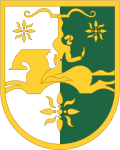| Order of Leon | |
|---|---|
| Awarded by | |
| Type | Order of merit |
| Established | 4 December 1992 |
| Eligibility | Abkhazian and foreign citizens |
| Awarded for | bravery in the service of the Republic of Abkhazia |
| Status | Active |
| Precedence | |
| Next (higher) | Order of Honour and Glory |
| Next (lower) | Order of Courage |
Order of Leon is an Order of the Republic of Abkhazia. [1]
Contents
Order of Leon has one class. It is awarded to is awarded to Abkhazian and foreign nationals for feats performed in a combat situation with a clear danger to life and ensuring the state security of the Republic of Abkhazia, in conditions associated with a risk to life. [2] The author of the design of the order is Valery Gamgia.
It is named after Leon II of Abkhazia.
